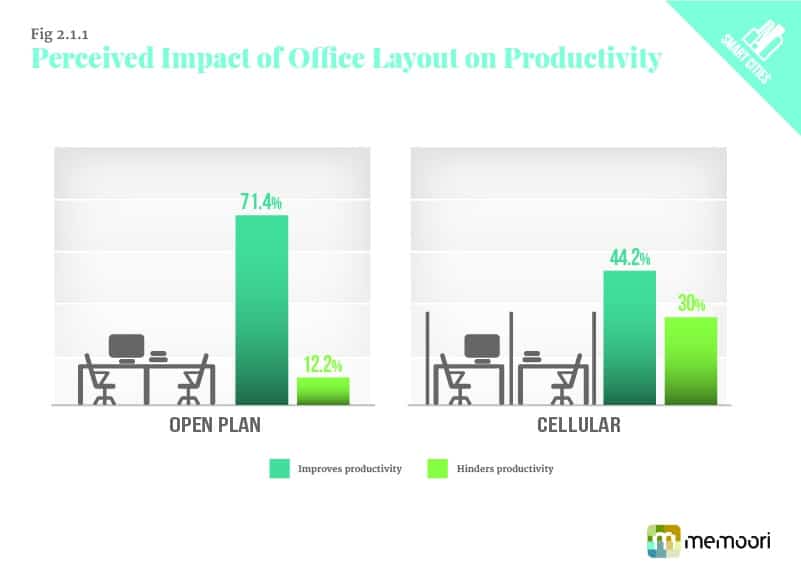According to a recent survey by Memoori, 71.4% of respondents in open plan offices say that the layout improves their productivity. In contrast, of the respondents working in cellular offices, only 44.2% say that layout improves productivity.
“This is our clearest indication that on the spectrum of open to cellular office layout, the significant majority of office workers feel more productive in open plan offices,” highlights The Future Workplace: Smart Office Design in the Internet of Things Era, a comprehensive report on the evolution of smart commercial buildings.
The critical debate in the ‘office layout’ section of the report is between open-plan and cellular offices, and therefore between isolation for focus versus accessibility for collaboration. Both collaboration and focus appear to be beneficial for increasing productivity, however these two elements are often at odds with one other; focused environments inhibit collaboration and collaborative environments lead to distraction.
“While employee focus may benefit from isolation, the human worker also has emotional needs and human collaboration is more complex than “necessary interactions.” As such, the workplace must cater for those needs while minimising counterproductive employee interactions and environmental elements,” the report explains.
Further to the initial statistic above, on the other side of the 71.4% of respondents in open plan offices believing the layout improves their productivity, only 12.2% of them say it hinders their productivity. Whereas, of the 44.2% of respondents working in cellular offices who say that the layout improves productivity are accompanied by as much as 30% who believe their cellular office layout hinders the speed and quality of their work.
“Our primary statistics produced by our survey suggest that adopting an open plan office will benefit the productivity of the majority, but hinder productivity for a large minority of workers,” says the report.
So while the productivity benefits of open plan office layout over a more cellular design are clear, and evident in modern workplace theory, the report goes much further. It describes how the latest incarnations of office design do not simply provide a choice between open and cellular layout. The new focus of modern office design is flexibility and through that you can maximise flexibility by offering each employee what they need to be productive at any given time.
“The answer to creating an office layout that maximizes productivity of the entire workforce is flexibility. Through flexibility you cater for the the varying needs and priorities of different types of employee across different generations, and crucially at different times to provide the ideal work environment for the variety of tasks each employee may need to undertake.

From this concept, the multi-space office layout was born. While on the surface the open office layout still dominates, those collaborative workplaces are now incorporating more and more areas for isolated, focused work time, as well as areas for relaxation or reflection, and others that inspire creative thinking,” explains the layout section of our comprehensive report.
By creating a flexible layout, offices can provide a collaborative environment to enhance productivity for the majority of workers and for the majority of the time, but also cater for the minority and for those who need occasional isolated work time. Only through this flexibility can companies hope to use layout to build on design theories of the past in order to maximize productivity in the future.
This is now a growing theme across the commercial real estate sector. "There is never going to be a perfect office, but organisations must create as much choice as possible to enable employees to vary noise levels to meet their needs depending on what they're working on," said Steve Lang, director of Savills Research and author of the 2016 ‘What Workers Want Survey’ in partnership with the British Council for Offices. "There should also be a desk-based solution for minimising noise levels at certain times, beyond simply donning the ubiquitous white headphones."
As our latest report highlights, design and technology is coming together in the Internet of Things era to bring about greater flexibility. While office layout may not depend as heavily on technology as other areas explored in the report, the key concept is the same; design spaces for the individual worker using a flexible layout, and by doing so you can raise the productivity of the entire enterprise.
[contact-form-7 id="3204" title="memoori-newsletter"]



